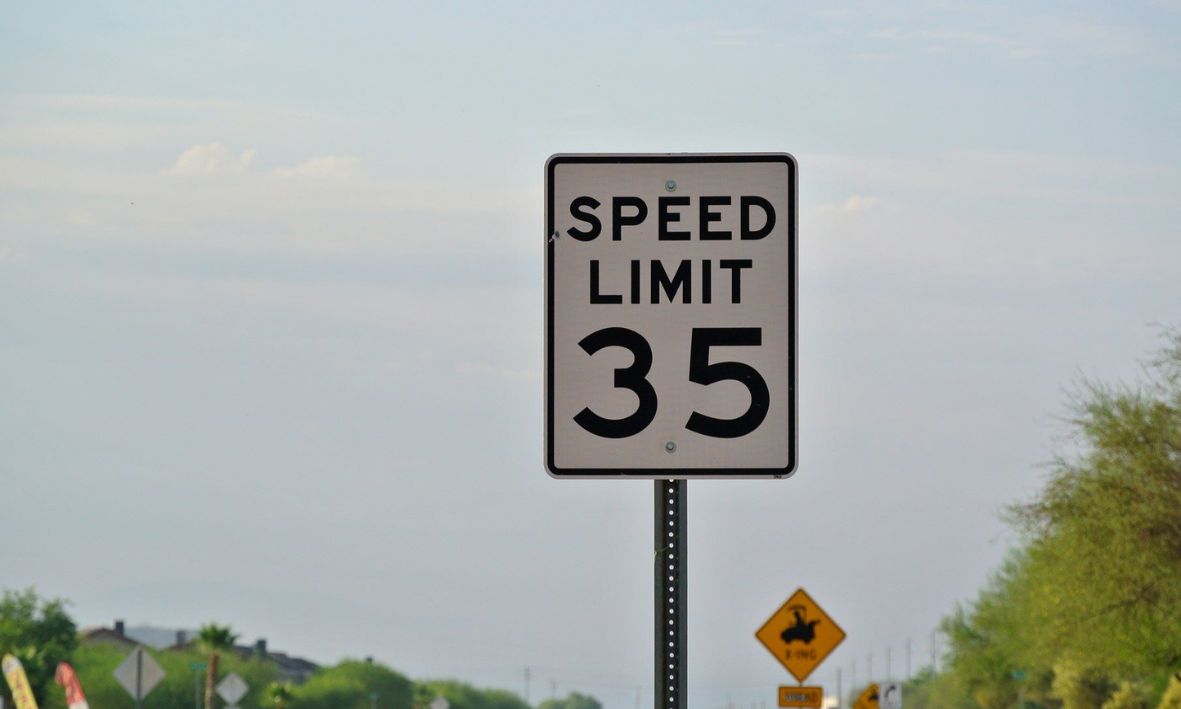The biggest reason for provoking crashes is the human behavior. Vehicle malfunction and environmental conditions provoke 6% of the crashes, while the other 94% are straight result of dangerous driving reaction. Traffic laws and violation statistics can vary by state and can change over time due to legislative updates or changes of enforcement priorities.
The most common driver violations include:
Speeding. Speeding is a common traffic violation that occurs when a driver exceeds the posted speed limits or drives too fast for the road conditions. Speed limits are established to promote safety on the roads and to reduce the risk of accidents. According to SambaSafety, “Speeding just 15 MPH over the limit increases the chance of a crash by 67%. Even drivers going slightly over the speed limit present incredible risk to the company, as those speeding less than 5 MPH over the limit are 36% more likely to be involved in a crash.” The consequences of a speeding violation can vary depending on the severity of the offense, local laws, and the speed at which the driver was traveling. Common penalties for speeding violations may include fines, points on the driver’s license, increased insurance rates, and in some cases, license suspension. This type of violation is a risk not only for the driver, but also to other road users and pedestrians. Law enforcement agencies use various methods, such as speed traps and radar guns, to monitor and enforce speed limits.

Distracted Driving. Distracted driving is another significant driver violation that involves engaging in activities that divert a person’s attention away from driving. Per SambaSafety “41% of crashes are due to inattentive driving”. Most common examples include: texting or using a mobile phone, eating and drinking, using in-car entertainment or navigation systems (adjusting the radio, GPS etc.).
Running Red Lights or Stop Signs. Traffic signals and stop signs are crucial for regulating the flow of traffic and preventing accidents at intersections. When a driver disregards these signals, they increase the likelihood of collisions and endanger pedestrians, cyclists and other motorists. Penalties for running red lights or stop signs can vary depending on the jurisdiction and the specific circumstances of the violation, such as, traffic tickets, points on license, traffic school, increased insurance rates and license suspension or revocation (the driver is temporarily or permanently prohibited from driving).

Driving under the influence (DUI). Driving Under the influence (DUI) or Driving While Intoxicated (DWI) is a serious and dangerous driver violation that involves operating a vehicle while impaired by alcohol or drugs. This violation is major concern for road safety, because impaired drivers are more likely to cause accidents, injuries and fatalities. For Class A commercial drivers can have serious consequences, both in terms of legal penalties and potential impact on their commercial driver’s license status. It is important to note that DUI/ DWI penalties can vary by state, and the Federal Motor Carrier Safety Administration (FMCSA) also has regulations governing these issues at the federal level. Some of the general considerations include: license suspension or disqualification, criminal penalties, CDL disqualification period (for at least one year, or up to three years if the offense involves transporting hazardous materials), employment consequences, substance abuse treatment programs (SAP).
Reckless Driving. Aggressive and dangerous driving behavior. Reckless driving is a serious violation that involves operating a vehicle with a willful and wanton disregard for the safety of others. It goes beyond simple negligence and implies conscious and intentional disregards for the potential consequences of one’s actions on the road. Reckless driving can encompass a variety of behaviors that endanger people or property. Examples of reckless driving are:
- Excessive speeding- driving at speeds significantly higher than posted speed limits or too fast for road conditions.
- Aggressive driving- engaging in aggressive behaviors such as tailgating, weaving in and out of traffic, or road rage incidents.
- Running Red Lights or Stop Signs.
- Overtaking in Unsafe Conditions- passing other vehicles in dangerous situations, such as on blind curves or in no-passing zones.
- Driving Under the Influence.
The penalties that apply for this type of violation can vary by jurisdiction, but they are in general more severe than those for typical traffic violations, such as: criminal charges, license points, mandatory driving school, insurance consequences, and criminal record.
Seat belt Violations. Not wearing a seat belt or not ensuring that passengers are properly restrained. Seat belt violations apply to all drivers, specifically to truck drivers. Wearing seat belts is a fundamental safety measure designed to protect drivers and passengers in the event of a collision or sudden stop. For truck drivers, the consequences of seat belt violation can include traffic tickets, fines, safety inspections, points on your CDL, impact on safety ratings (negative record).

Expired or No Driver’s License. Driving without a valid driver’s license, including an expired license, is a serious offense for any holder of CDL A Class license. According to SambaSafety’s insights, around 3 to 5% of individuals drive with a suspended license at any point in time. These drivers pose an extreme risk, as 19% of all U.S. driving fatalities involve drivers with invalid licenses6. 80% of these suspensions are due to administrative reasons, such as failing to pay child support (which increases the likelihood of a crash by 53.6%.)
The penalties depend by state, and they can depend on factors such as whether the driver has never had a license, had an expired license, or is operating with a suspended or revoked license. If a truck driver does not have a valid Class A license, he/ she can be charged with:
- A traffic violation
- Vehicle Impoundment
- Criminal charge
- CDL Disqualification
- Employment consequences
Failure to yield. Not yielding the right of way as required by traffic laws. Failure to yield is a traffic violation that occurs when a driver does not give the right of way to another vehicle or pedestrian when required to do so by traffic laws. Failure to yield, whether for truck drivers or other motorists, is a serious traffic violation that can lead to accidents and pose risks to road safety. The consequences for a truck driver failing to yield can vary depending on the specific circumstances, the severity of the violation, and the laws of the jurisdiction in which the violation occurs. For truck drivers, failure to yield can have serious consequences, including:
- Traffic tickets
- Fines
- License Points
- Safety Violations
- Insurance Consequences
- Employment Consequences
Improper Lane Changes. Class A drivers, who operate large commercial vehicles, are held to high safety standards, and improper lane changes can pose significant risks on the road. It can provoke accidents, especially when operating large commercial vehicles. These accidents can result in injuries, property damage and potential legal consequences for the driver and the company. The penalties for improper lane changes can vary by jurisdiction, and some of them are:
- Traffic Violation Fines
- Traffic Violation Points
- Commercial Driver’s License (CDL) Consequences
- Employment Consequences
- Potential Safety Risks.
To avoid improper lane change violations, truck drivers should always use their turn signals, check blind spots, and ensure it is safe to change lanes.
Failure to signal. Not using turn signals when required. Failure to signal, also known as not using turn signals or indicators, is a traffic violation that occurs when a driver fails to communicate their intentions to other road users by not using their vehicle’s turn signals. This violation applies to all drivers, including truck drivers.
Consequences for failure to signal as a truck driver violation may include traffic tickets, fines, license points, safety concerns, insurance consequences, employment consequences. Truck drivers should always give a signal when they try to change position or direction on the road, and implement the MSM routine. MSM- Mirror- Signal- Manoeuvre routine.
It’s important for truck drivers to be aware of and comply with traffic laws, especially those related to yielding the right of way. This includes understanding the rules for specific road situations, intersections, and merging lanes. Training and awareness of traffic safety guidelines are crucial for all drivers, but particularly for commercial truck drivers who operate large and potentially hazardous vehicles.


